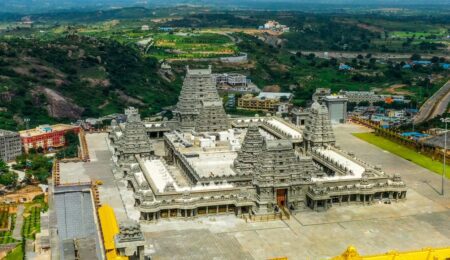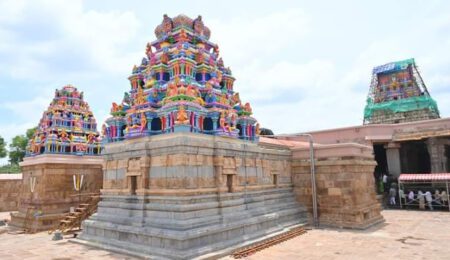Airavatesvara Temple – A Complete Guide to the Chola Masterpiece in Darasuram, Tamil Nadu
Introduction
The Airavatesvara Temple, located in Darasuram near Kumbakonam, Tamil Nadu, is one of the most magnificent creations of the Chola dynasty. Dedicated to Lord Shiva and recognized as a UNESCO World Heritage Site, it stands as a testament to the artistic brilliance, spiritual devotion, and architectural innovation of the Chola rulers.
Built in the 12th century by Rajaraja Chola II, this temple is part of the illustrious trio known as the Great Living Chola Temples, which also includes the Brihadisvara Temple at Thanjavur and the Gangaikonda Cholapuram Temple. Unlike its larger counterparts, Airavatesvara is celebrated not for its sheer size but for its intricate details, fine carvings, and exceptional preservation.
In this guide, you’ll discover everything about the Airavatesvara Temple: its fascinating history, divine legends, exquisite sculptures, architectural brilliance, how to reach, best time to visit, and travel tips to make your journey unforgettable.
Historical Background of Airavatesvara Temple
The Chola Era – A Golden Age of Art & Architecture
The Chola dynasty, which ruled large parts of South India between the 9th and 13th centuries CE, is renowned for its contributions to Dravidian temple architecture. Their reign marked a period of immense cultural, economic, and political prosperity, with art, music, dance, and literature flourishing under their patronage.
The Airavatesvara Temple was commissioned by Rajaraja Chola II (1146–1173 CE), a ruler known for his devotion to Shaivism (worship of Lord Shiva) and his patronage of fine arts. This temple was not only a place of worship but also served as a hub for religious gatherings, cultural performances, and scholarly activities.
Legends of Airavatesvara Temple
The Legend of Airavata
The temple gets its name from Airavata, the white elephant of Lord Indra (king of the heavens). Legend says that Airavata was cursed by Sage Durvasa to lose his white complexion. Seeking relief, Airavata prayed to Lord Shiva at this temple and regained his original form after bathing in the temple tank. Hence, the deity came to be known as Airavatesvarar.
Yama’s Penance
Another legend mentions that Yama, the God of Death, was suffering from a curse that caused his skin to burn. He too prayed to Lord Shiva at this temple and was relieved of his suffering after taking a dip in the sacred waters.
These legends highlight the temple’s reputation as a place of healing and spiritual renewal.
Architectural Brilliance of Airavatesvara Temple
A Chariot-Like Structure
One of the most striking features of the temple is its chariot-shaped structure, drawn by stone horses. This symbolic representation reflects the dynamic nature of life and spirituality in Chola philosophy.
Vimana and Sanctum
The sanctum (garbhagriha) is crowned by a three-tiered vimana (tower), which stands about 24 meters high, intricately carved with deities, celestial beings, and mythological scenes.
Rajagambhira Mandapa
This main hall is the centerpiece of the temple’s design. It features:
- Pillars with exquisitely detailed carvings
- Sculptures of musicians and dancers
- Narratives from Hindu epics like the Ramayana and Mahabharata
Stone Inscriptions
The walls of the temple bear extensive inscriptions that provide insights into the Chola administration, temple rituals, donations, and cultural practices of the time.
Sculptural Highlights
The Airavatesvara Temple is a treasure trove of Chola sculptural artistry. Some highlights include:
- 108 Dance Postures of Bharatanatyam: Carved with precision, these depict classical dance poses still practiced today.
- Depictions of Daily Life: Farmers, artisans, dancers, and royal processions are portrayed with lifelike expressions.
- Mythological Figures: Sculptures of Lord Shiva in various forms – Nataraja (Lord of Dance), Ardhanarishvara (half male, half female form), and Dakshinamurthy (divine teacher).
- Yakshis and Apsaras: Celestial maidens adorn the walls, representing grace and prosperity.
Religious Significance
The presiding deity, Lord Airavatesvarar (Shiva), is worshipped in the form of a lingam. The temple continues to be an active site of worship, with daily rituals and annual festivals celebrated by devotees.
The sacred temple tank, believed to have curative properties, attracts pilgrims seeking spiritual and physical healing.
UNESCO World Heritage Recognition
In 2004, the Airavatesvara Temple, along with the Brihadisvara Temple at Thanjavur and the Gangaikonda Cholapuram Temple, was designated as a UNESCO World Heritage Site under the title “Great Living Chola Temples.”
This recognition emphasizes its global significance, not just as an architectural marvel, but also as a living monument where traditions and rituals are still practiced.
Best Time to Visit
- Winter (November to February): The most comfortable season for exploring the temple.
- Early Morning or Evening: Ideal for photography and enjoying the carvings in soft sunlight.
- Festivals: Maha Shivaratri and Chithirai festival bring the temple to life with rituals and celebrations.
How to Reach Airavatesvara Temple
- By Air: Nearest airport is Tiruchirappalli (Trichy), 90 km away.
- By Train: Kumbakonam Railway Station, 5 km from the temple.
- By Road: Regular buses and taxis from Kumbakonam (4 km), Thanjavur (35 km), and other nearby towns.
Timings & Entry Fees
- Temple Hours: 6:00 AM – 12:30 PM & 4:00 PM – 8:30 PM
- Entry Fee: Free for all visitors
- Photography: Allowed (drones may need special permission)
Visitor Tips
- Dress modestly; traditional attire is recommended.
- Remove footwear before entering the sanctum.
- Hire a local guide for a deeper understanding of the sculptures.
- Combine your trip with other Chola heritage sites for a complete experience.
Nearby Attractions
- Brihadisvara Temple, Thanjavur (35 km)
- Gangaikonda Cholapuram (40 km)
- Adi Kumbeswarar Temple, Kumbakonam
- Mahamaham Tank, Kumbakonam
- Darasuram Silk Weaving Centers
Frequently Asked Questions (FAQs)
1. Why is Airavatesvara Temple famous?
It is renowned for its intricate Chola architecture, fine carvings, and being part of the UNESCO-listed Great Living Chola Temples.
2. Who built Airavatesvara Temple?
Rajaraja Chola II built the temple during the 12th century CE.
3. Is Airavatesvara Temple still active?
Yes, it remains an active temple with daily worship and festivals.
4. How much time is needed to explore the temple?
Typically, 1–2 hours is enough to explore its sculptures, mandapas, and surrounding areas.
5. Are there guided tours available?
Yes, local guides and government-approved guides are available near the temple entrance.
Conclusion
The Airavatesvara Temple in Darasuram is a living monument that bridges the past and present, inviting travelers, historians, and devotees alike to witness the pinnacle of Chola artistry. Its chariot-like structure, fascinating legends, breathtaking sculptures, and spiritual ambiance make it a must-visit heritage site in Tamil Nadu.
If you’re exploring the cultural treasures of South India, this temple is not just a stop it’s an unforgettable journey into history, devotion, and divine artistry.




Leave a Comment